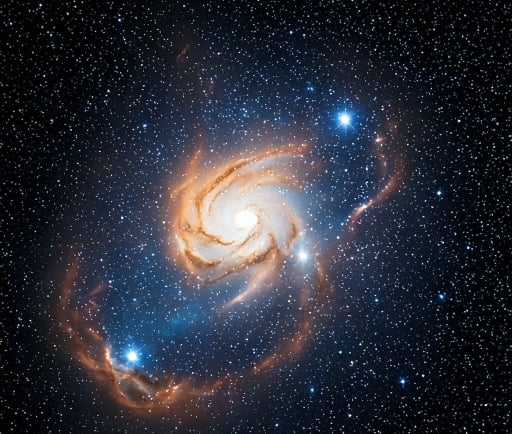The Floating Small Magellanic Cloud: Amidst the Spiral Galaxy


Introduction to the Small Magellanic Cloud
The Small Magellanic Cloud (SMC) is an irregular dwarf galaxy located near the Milky Way, and it has captivated astronomers and stargazers alike. This celestial body offers a unique opportunity to study galactic interactions and the processes of star formation in a comparably smaller, more manageable context. Positioned approximately 200,000 light-years away, the SMC serves as a fascinating neighboring galaxy within our local group.
The Formation and Structure of the SMC
The Small Magellanic Cloud is composed of a complex structure, primarily made up of gas and dust, with numerous star-forming regions dotting its landscape. Its irregular shape and varying density contribute to its classification as a dwarf galaxy, which distinguishes it from larger, more defined spiral galaxies. The SMC's stellar population includes both young and old stars, showcasing the galaxy's rich history of star formation.
The galaxy is also known for its striking presence in the night sky, often appearing as a cloudy patch when observed from Earth's southern hemisphere. Through advanced telescopic observations, researchers have identified several intriguing features within the SMC, including massive star clusters and nebulae, which provide insights into the lifecycle of stars.
The SMC within the Context of the Spiral Galaxy
In the grand tapestry of the universe, the Small Magellanic Cloud holds strategic importance as it orbits the Milky Way, offering valuable data regarding the dynamics between different galactic formations. The gravitational interactions between the Milky Way and the SMC potentially influence the development of each galaxy. The SMC is also thought to play a role in the Milky Way's overall evolution, acting as a reservoir of gas that can feed accretion processes in our spiral galaxy.
Moreover, the relationship between the SMC and larger spiral galaxies emphasizes the complexity of cosmic evolution. Studies have shown that the gravitational pull from the Milky Way may have decelerated the SMC's star formation rate, highlighting the interconnectedness of galaxies.
The Future of Observational Astronomy within the SMC
The Small Magellanic Cloud continues to be an object of interest for astronomers seeking to deepen their understanding of galactic behavior. With cutting-edge telescopes and instrumentation, researchers can further examine the physical and chemical processes at play within this enchanting dwarf galaxy. The SMC presents a unique laboratory for testing theoretical models of galaxy formation, particularly regarding the role of external gravitational influences.
Furthermore, as space technology advances, collaborative projects involving the SMC could enhance our grasp of galactic dynamics. By observing the interactions of the SMC within the cosmic neighborhood, scientists can derive new insights that may redefine our understanding of galaxies and their classifications.
In conclusion, the Small Magellanic Cloud holds a prominent place in the study of cosmic structures amidst the vast expanse of the spiral galaxy. Its unique characteristics and relationship with the Milky Way unveil deeper aspects of astrological significance, continuing to inspire generations of astronomers and enthusiasts alike.
